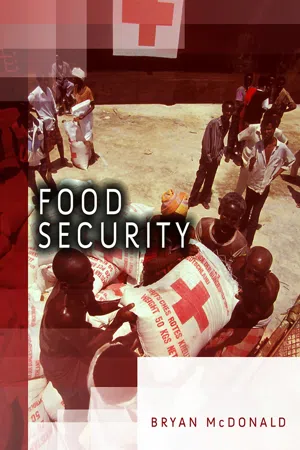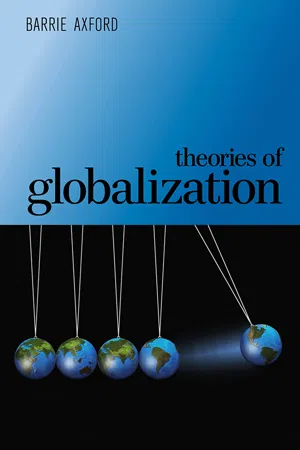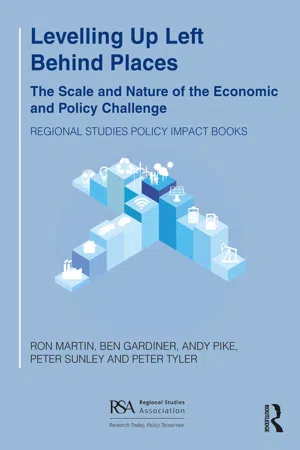Global Shift
"Global Shift" refers to the ongoing process of economic and industrial transformation, marked by the movement of manufacturing and service industries from developed to developing countries. This shift has significant implications for global trade, employment patterns, and the distribution of wealth and power. It is driven by factors such as technological advancements, changes in consumer demand, and the pursuit of cost efficiencies.
4 Key excerpts on "Global Shift"
- eBook - ePub
Regional Geography (RLE Social & Cultural Geography)
Current Developments and Future Prospects
- Ron Johnston, Joost Hauer, G. Hoekveld(Authors)
- 2014(Publication Date)
- Routledge(Publisher)
...Certainly, not only is the geography of the current transformation remarkably varied and dynamic, but geographical restructuring is a centrally important feature of it. In accounting for the change from organized to disorganized capitalism, Lash Scott Lash and John Urry (1987:84) argue that ‘there is in the spatial an aspect of social relationships’, that there are ‘particular spatial patterns associated with each of these phases of capitalist development’, and, in elucidating ‘what it is like to be “modern”, to live in a modern age’, they stress the ‘extraordinary spatial and temporal transformations … that substantially organize our experience of modern social life’. Not surprisingly, then, the diversity of transition and the fragmentation of previous wholes has led to an increased concern with the geographically distinctive and local and has encouraged a mode of theorizing which stresses fragmentation and unintended consequences. This, I would argue, is extremely dangerous. ‘We still live in a world dominated by capitalism’, and ‘broad social change’ cannot be reduced to the ‘inchoate swirl of human agency’ (Harvey and Scott 1989). Related to this is Neil Smith’s (1987b) critique of realism in which the distinction between necessary and contingent relations leads to the conclusion that, as a product of contingent relations, geography is not accessible to abstract theory. If our objective is to change rather than merely to understand the world, the significance of regional geography lies in reminding us of the ever-present possibilities of making alternative geographies. If the ‘essence of the intellectual enterprise we are engaged in is to construct sustainable generalizations’, regional geography enables us to ‘judge when these generalizations are no longer sustainable’ (Smith 1987b:67)...
- eBook - ePub
- Bryan L. McDonald(Author)
- 2013(Publication Date)
- Polity(Publisher)
...1999; Luke 2001b; Gereffi, Humphrey, and Sturgeon 2005; McNeill 2008). In considering the perspectives of all three of Held et al.’s approaches to understanding globalization (hyperglobalist, skeptical, and transformational), as well as discussions about the historical nature of these processes, we can thus further refine the definition of globalization employed by this book. Held et al. offer a revised conceptualization of globalization as “a process (or set of processes) which embodies a transformation in the spatial organization of social relations and transactions – assessed in terms of their extensity, intensity, velocity and impact – generating transcontinental or interregional flows and networks of activity, interaction and exercise of power” (Held et al. 1999: 16). In reviewing these many ideas and definitions of globalization then, we can understand globalization as a phenomenon that has certain key elements: • Rate – globalization increases the speed of interactions • Magnitude – globalization increases the scale of interactions • Structure – globalization operates through networks of systems • Effect – globalization is transforming economic, social and political systems Collectively, globalization can be understood as a set of processes involving increasing speed and scale of interactions that operate through networks and that are transforming many aspects of daily life (Held et al. 1999; Matthew and Shambaugh 2005). Modern globalization brings new opportunities for improving human livelihoods and well-being, but also brings greater recognition of the persistent sources of human insecurity from threats such as a lack of sufficient food. Globalization may be increasing the speed and scale of transnational interactions, but the effects, both positive and negative, of globalization remain unevenly distributed. Timothy W...
- eBook - ePub
- Barrie Axford(Author)
- 2014(Publication Date)
- Polity(Publisher)
...The first theme is the globalization–territory debate and the concepts of de- and supra-territorialization. In turn, this raises the issue of state–space, of ‘stateness’ and the changing territorialization of political power. The second, related theme bears on the mutability of geographical scales and of scale as a feature of social processes. The third focuses on the dialectic of networks and borders and provides insights into the tortuous extension of social relations across world space. Let's rehearse the issues at stake in what follows: globalization is undoubtedly a geographical term that denotes ‘a process over time of spatial change – the process of becoming worldwide’ (Rosenberg, 2005, 11). While this definition allows Rosenberg to agree that the relational form of any society is ‘inseparable’ from particular constellations of space and time, he is dismissive of the idea that the ‘spatio-temporal dimension of human social reproduction is in some way ontologically prior to other dimensions’ and of the abstraction of spatial and temporal dimensions of social life from their ‘human, relational dynamics’ in actual societies (2005, 13). Thinking about spatial patterns or topologies is a key part of the shift away from simple Euclidean notions of the ordering of social and political life. For all the talk of a post-Westphalian (post-state/post-territorial) social science, the regional metaphor is routinely used to analyse social wholes, mainly because it is natural seeming (Mol and Law, 1994, 643). Territory and Territoriality in a Globalizing World Theories of social space also subsist as theories of territory and of territoriality, especially with regard to the idea of state space or the spatiality of the state (Brenner and Elden, 2009)...
- eBook - ePub
Levelling Up Left Behind Places
The Scale and Nature of the Economic and Policy Challenge
- Ron Martin, Ben Gardiner, Andy Pike, Peter Sunley, Peter Tyler(Authors)
- 2021(Publication Date)
- Routledge(Publisher)
...3. WHY PLACES HAVE FALLEN BEHIND: THE GEOGRAPHICALLY UNEVEN EFFECTS OF ECONOMIC TRANSFORMATION 10.4324/9781032244341-3 Keywords: Economic transformation, deindustrialization, post-industrial economy, knowledge-intensive services, public sector, local skills The significance of deindustrialization can therefore be evaluated only in terms of how rapidly and how successfully workers dislocated from so-called sunset industries are reemployed in growing, sunrise industries. 1 3.1 EVOLVING GEOGRAPHIES OF ECONOMIC TRANSFORMATION As Chapter 2 explained, during the past four decades or so, advanced countries have experienced a switch from spatial convergence and the gradual decline of spatial inequalities to an era of divergence and growing regional and local inequalities. The intensification of divergence has been such that it is no exaggeration to say that it has become a force tearing at the cohesion and collective belonging of Western liberal societies. 2 There have been a growing number of attempts to understand the economic forces behind this increase in spatial inequalities. There is some agreement that the rapid progress of technological change together with globalization and the growth of consumer and business services have been crucial. Together, such forces have produced an era of economic turmoil and “creative destruction” as some manufacturing industries have declined while other service sectors have grown rapidly. This round of “creative destruction” has had profoundly uneven geographical dimensions, and some places have lost their economic rationale, while others have found new roles and sources of value creation. This chapter examines how the spatial distribution of employment growth has changed in this unstable period of transition, and which types of area have struggled to capture significant employment growth...



